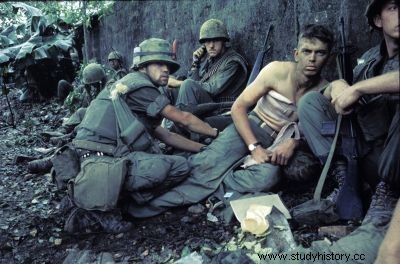
By late 1967, part of the ruse had been staged:the border battles of Song Be, Loc Ninh and Dak To. By mid-January 1968, guns and men were in place to deploy another centerpiece of the deception:the diversion of Khe Sanh. The operation began on January 21 with the intensive bombardment of the American base with mortars, rockets, artillery shells, and continued, with varying intensity, for some eleven weeks.
In South Vietnam, as Tet approached, the growing concern of Westmoreland and his commanders had spread among some South Vietnamese. Although he could not bring himself to cancel the Tet leaves granted to his troops, President Thieu, under pressure from Westmoreland, accepted that at least 50 percent of the South Vietnamese troops - some 732,000 men at the time — were on guard.
Despite all the caution taken in the preparations for Hanoi, an error slipped into the schedule of the offensive. Before dawn on January 30, as merry revelers lined the streets and set off firecrackers, the Communists attacked eight towns and cities in the central Highlands and central coastal provinces. In addition, a ground attack of the strength of a battalion was carried on the port of Nha Trang. Another hit Hoi An, a district capital located near the coast. Mortar and rocket fire preceded the infantry attack on Ban Me Thuot, a town in the Hauts Plateaux. The sappers were launched against the ARVN I Corps headquarters in Da Nang. Two battalions took part in the ground attack on Qui Nhon, whose garrison had been on high alert since the capture of the propaganda tapes mentioned above. Pleiku and the capital of a distant district also came under attack.
The warning given to the Americans and South Vietnamese by these premature attacks was brief but precious. Major General Phillip B. Davidson, Westmoreland's Chief Intelligence Officer, predicted, "The sequel is coming to the rest of the country tonight or tomorrow morning." When day broke on January 30, President Thieu called off the nationwide ceasefire and put all South Vietnamese military units on alert—a decision Westmoreland had already made for American units. But it was too late to recall the South Vietnamese soldiers who had already gone on leave. Also too late to eliminate the communist soldiers in civilian clothes who, for days, had infiltrated the towns and cities, mingling with the crowd of South Vietnamese who traveled on the occasion of the holidays...
